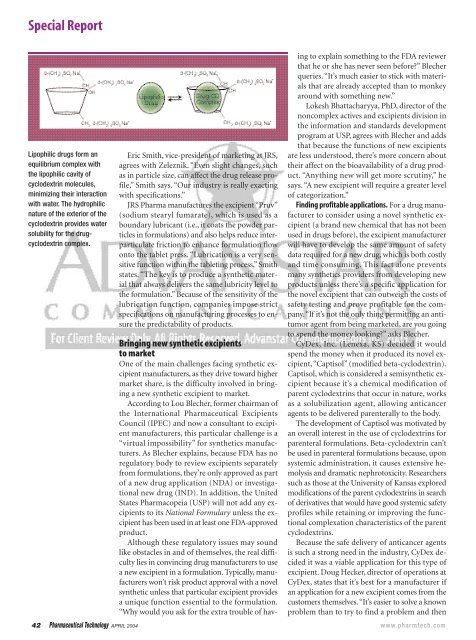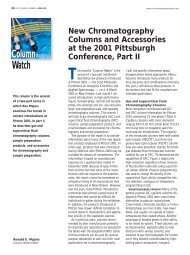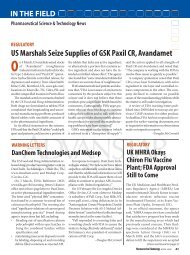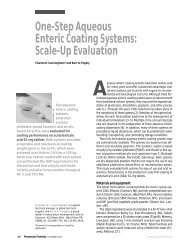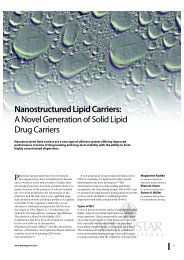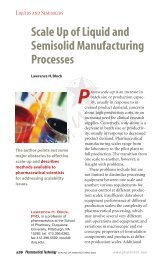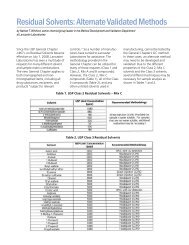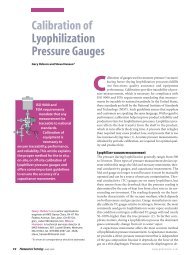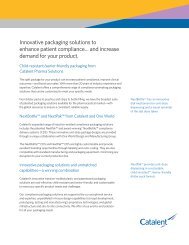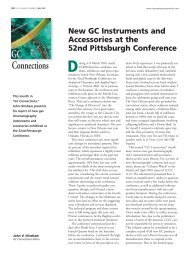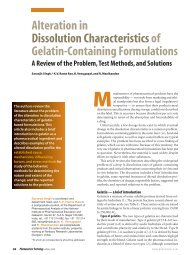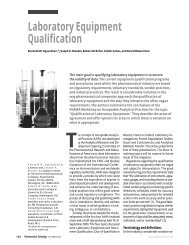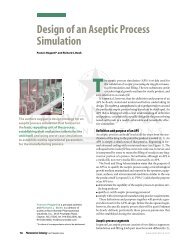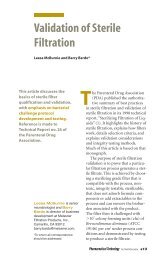Synthetic Excipients Challenge All-Natural Organics Synthetic ...
Synthetic Excipients Challenge All-Natural Organics Synthetic ...
Synthetic Excipients Challenge All-Natural Organics Synthetic ...
Create successful ePaper yourself
Turn your PDF publications into a flip-book with our unique Google optimized e-Paper software.
Special Report<br />
Lipophilic drugs form an<br />
equilibrium complex with<br />
the lipophilic cavity of<br />
cyclodextrin molecules,<br />
minimizing their interaction<br />
with water. The hydrophilic<br />
nature of the exterior of the<br />
cyclodextrin provides water<br />
solubility for the drugcyclodextrin<br />
complex.<br />
Eric Smith, vice-president of marketing at JRS,<br />
agrees with Zeleznik. “Even slight changes, such<br />
as in particle size, can affect the drug release profile,”<br />
Smith says. “Our industry is really exacting<br />
with specifications.”<br />
JRS Pharma manufactures the excipient “Pruv”<br />
(sodium stearyl fumarate), which is used as a<br />
boundary lubricant (i.e., it coats the powder particles<br />
in formulations) and also helps reduce interparticulate<br />
friction to enhance formulation flow<br />
onto the tablet press. “Lubrication is a very sensitive<br />
function within the tableting process,” Smith<br />
states. “The key is to produce a synthetic material<br />
that always delivers the same lubricity level to<br />
the formulation.” Because of the sensitivity of the<br />
lubrication function, companies impose strict<br />
specifications on manufacturing processes to ensure<br />
the predictability of products.<br />
Bringing new synthetic excipients<br />
to market<br />
One of the main challenges facing synthetic excipient<br />
manufacturers, as they drive toward higher<br />
market share, is the difficulty involved in bringing<br />
a new synthetic excipient to market.<br />
According to Lou Blecher, former chairman of<br />
the International Pharmaceutical <strong>Excipients</strong><br />
Council (IPEC) and now a consultant to excipient<br />
manufacturers, this particular challenge is a<br />
“virtual impossibility” for synthetics manufacturers.<br />
As Blecher explains, because FDA has no<br />
regulatory body to review excipients separately<br />
from formulations, they’re only approved as part<br />
of a new drug application (NDA) or investigational<br />
new drug (IND). In addition, the United<br />
States Pharmacopeia (USP) will not add any excipients<br />
to its National Formulary unless the excipient<br />
has been used in at least one FDA-approved<br />
product.<br />
Although these regulatory issues may sound<br />
like obstacles in and of themselves, the real difficulty<br />
lies in convincing drug manufacturers to use<br />
a new excipient in a formulation. Typically, manufacturers<br />
won’t risk product approval with a novel<br />
synthetic unless that particular excipient provides<br />
a unique function essential to the formulation.<br />
“Why would you ask for the extra trouble of having<br />
to explain something to the FDA reviewer<br />
that he or she has never seen before?” Blecher<br />
queries. “It’s much easier to stick with materials<br />
that are already accepted than to monkey<br />
around with something new.”<br />
Lokesh Bhattacharyya, PhD, director of the<br />
noncomplex actives and excipients division in<br />
the information and standards development<br />
program at USP, agrees with Blecher and adds<br />
that because the functions of new excipients<br />
are less understood, there’s more concern about<br />
their affect on the bioavailability of a drug product.<br />
“Anything new will get more scrutiny,” he<br />
says. “A new excipient will require a greater level<br />
of categorization.”<br />
Finding profitable applications. For a drug manufacturer<br />
to consider using a novel synthetic excipient<br />
(a brand new chemical that has not been<br />
used in drugs before), the excipient manufacturer<br />
will have to develop the same amount of safety<br />
data required for a new drug, which is both costly<br />
and time consuming. This fact alone prevents<br />
many synthetics providers from developing new<br />
products unless there’s a specific application for<br />
the novel excipient that can outweigh the costs of<br />
safety testing and prove profitable for the company.“If<br />
it’s not the only thing permitting an antitumor<br />
agent from being marketed, are you going<br />
to spend the money looking?” asks Blecher.<br />
CyDex, Inc. (Lenexa, KS) decided it would<br />
spend the money when it produced its novel excipient,<br />
“Captisol” (modified beta-cyclodextrin).<br />
Captisol, which is considered a semisynthetic excipient<br />
because it’s a chemical modification of<br />
parent cyclodextrins that occur in nature, works<br />
as a solubilization agent, allowing anticancer<br />
agents to be delivered parenterally to the body.<br />
The development of Captisol was motivated by<br />
an overall interest in the use of cyclodextrins for<br />
parenteral formulations. Beta-cyclodextrin can’t<br />
be used in parenteral formulations because, upon<br />
systemic administration, it causes extensive hemolysis<br />
and dramatic nephrotoxicity. Researchers<br />
such as those at the University of Kansas explored<br />
modifications of the parent cyclodextrins in search<br />
of derivatives that would have good systemic safety<br />
profiles while retaining or improving the functional<br />
complexation characteristics of the parent<br />
cyclodextrins.<br />
Because the safe delivery of anticancer agents<br />
is such a strong need in the industry, CyDex decided<br />
it was a viable application for this type of<br />
excipient. Doug Hecker, director of operations at<br />
CyDex, states that it’s best for a manufacturer if<br />
an application for a new excipient comes from the<br />
customers themselves.“It’s easier to solve a known<br />
problem than to try to find a problem and then<br />
42 Pharmaceutical Technology APRIL 2004 www.pharmtech.com


